The AMD A8-3850 Review: Llano on the Desktop
by Anand Lal Shimpi on June 30, 2011 3:11 AM ESTEver since the arrival of Conroe back in 2006, we've only really recommended AMD for its (sometimes incredible) value. Recommending AMD for those looking for absolute performance pretty much ended when the Pentium 4 retired.
AMD is looking to change that with the arrival of its first Fusion APUs. These APUs marry one or more AMD x86 cores with dozens if not hundreds of Radeon "cores" on a single die. While today the APU is little more than a cohabitation of these two computing architectures, the end goal is something far more integrated:

Llano is AMD's second Fusion APU, the first being Zacate which we met earlier this year. Llano shouldn't be all that unfamiliar to you either, the notebook version of the APU launched just two weeks ago. Our conclusions were as you'd expect: sub-par x86 performance but competitive battery life and great gaming performance for a value notebook. If gaming is going to be the most intensive thing you do on your notebook, you may find yourself wanting one based on a Llano APU.
Now it's time to look at Llano on the desktop. We previewed the desktop Llano alongside the mobile version but today we're back with much more detail. This article will focus on the basics: CPU performance, GPU performance and the associated details. Ian has a final review of one of the first desktop Llano motherboards - the ASRock A75 Extreme6 as well as a look at overclocking the new desktop APU. Finally Ganesh's article takes an in-depth look at how Llano works as an HTPC platform.
The APU
Although mobile Llano has to worry about fitting into thin and light notebooks, the desktop version has a lot more breathing room and as a result it comes to us in a pretty traditional package. Motherboard backwards compatibility is thrown out the window as you need pins to get video output from the APU to an on-board VGA/DVI/HDMI header and as a result we have a new platform: Socket-FM1.
Socket-FM1 is a 905-pin ordeal that looks reminiscent of the original Clawhammer CPU:
Despite the socket change, heatsink specifications haven't changed. All existing Socket-AM2/AM2+/AM3/AM3+ heatsinks should work just fine as long as they can handle the rated TDP of the chip you're cooling.
The desktop Llano launch starts small. AMD is only introducing four parts today, two of which will be available later:
| AMD Llano Desktop Lineup | |||||||||
| GPU | Total TDP (GPU + CPU) | CPU Cores | CPU Clock (Base/Turbo) | GPU Cores | GPU Clock | Price | |||
| AMD A8-3850 | Radeon HD 6550D | 100W | 4 | 2.9GHz | 400 | 600MHz | $135 | ||
| AMD A8-3800 | Radeon HD 6550D | 65W | 4 | 2.4/2.7GHz | 400 | 600MHz | $?? | ||
| AMD A6-3650 | Radeon HD 6530D | 100W | 4 | 2.6GHz | 320 | 443MHz | $115 | ||
| AMD A6-3600 | Radeon HD 6530D | 65W | 4 | 2.1/2.4GHz | 320 | 443MHz | $?? | ||
The A8-3850 and A6-3650 are going to be the first Llano APUs available, both carry a 100W TDP rating. While this may seem high, do remember that 100W is for the CPU and GPU combined.
Although Llano does support AMD's new Turbo Core technology, neither of the parts launching today have it enabled. The A8-3850 and A6-3650 run at 2.9GHz and 2.6GHz, respectively. The 3800 and 3600 will drop base clock speeds to hit a lower TDP but allow you to turbo up depending on workload. For an explanation of how Turbo Core works, flip back to our mobile Llano article.
Pricing is pretty reasonable. For $98 you can buy an Athlon II X4 640 running at 3.0GHz. For $37 more AMD will sell you an A8-3850 APU, effectively determining the price of the integrated GPU. AMD expects to see desktops built around the A6 to sell for $500 - $600, and A8 based systems to go for between $600 and $700
| CPU Specification Comparison | ||||||||
| CPU | Manufacturing Process | Cores | Transistor Count | Die Size | ||||
| AMD Llano 4C | 32nm | 4 | 1.45B | 228mm2 | ||||
| AMD Thuban 6C | 45nm | 6 | 904M | 346mm2 | ||||
| AMD Deneb 4C | 45nm | 4 | 758M | 258mm2 | ||||
| Intel Gulftown 6C | 32nm | 6 | 1.17B | 240mm2 | ||||
| Intel Nehalem/Bloomfield 4C | 45nm | 4 | 731M | 263mm2 | ||||
| Intel Sandy Bridge 4C | 32nm | 4 | 995M | 216mm2 | ||||
| Intel Lynnfield 4C | 45nm | 4 | 774M | 296mm2 | ||||
| Intel Clarkdale 2C | 32nm | 2 | 384M | 81mm2 | ||||
| Intel Sandy Bridge 2C (GT1) | 32nm | 2 | 504M | 131mm2 | ||||
| Intel Sandy Bridge 2C (GT2) | 32nm | 2 | 624M | 149mm2 | ||||
Architecturally desktop Llano is no different than its mobile counterpart. These are all quad-core parts with updated 32nm cores, boasting a ~6% increase in IPC over their 45nm Athlon II predecessors. Each core has a private 1MB L2 cache for a total of 4MB per quad-core APU.
The GPU side isn't different architecturally either, you're still looking at a Sumo core derived from AMD's Radeon HD 5570. Desktop Llano is available with either 400 GPU cores or 320 cores (you can get the mobile part with only 240 cores enabled as well). While the mobile parts top out at 444MHz, the extra TDP available in a desktop chassis allows AMD to ratchet up the GPU clock to 600MHz for the A8-3850.
AMD calls the two GPU configurations the Radeon HD 6550D and 6530D. Just like you can with mobile Llano, you can also pair a desktop Llano APU with a discrete GPU to have them both run in an asymmetrical CrossFire mode (with limitations of course):
| AMD Radeon Dual Graphics Branding | ||||
| Discrete GPU | 6550D | 6530D | ||
| HD 6670 | HD 6690D2 | HD 6690D2 | ||
| HD 6570 | HD 6630D2 | HD 6610D2 | ||
| HD 6450 | HD 6550D2 | HD 6550D2 | ||
The Chipset
I hate to keep drawing comparisons between desktop and mobile Llano APUs but we also have two chipsets on the desktop side: A75 and A55. The A75 chipset is the high end option with 6 x 6Gbps SATA ports and 4 x USB 3.0 ports:
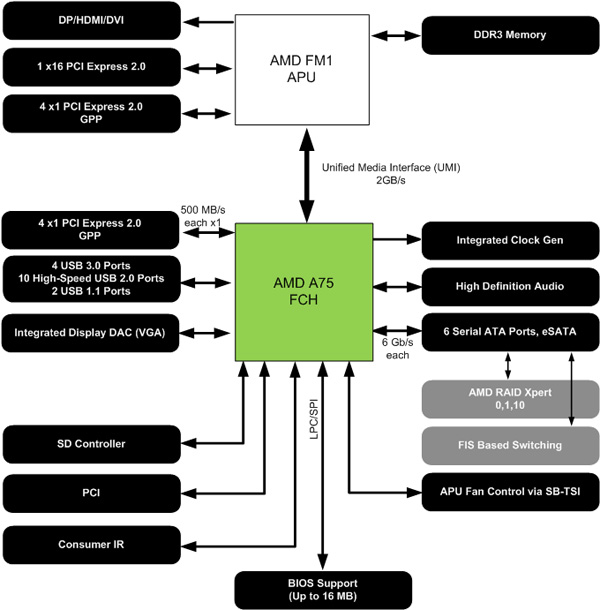
The A55 is the lower power, cost effective option that gets rid of all USB 3.0 support and backs down to 3Gbps SATA:
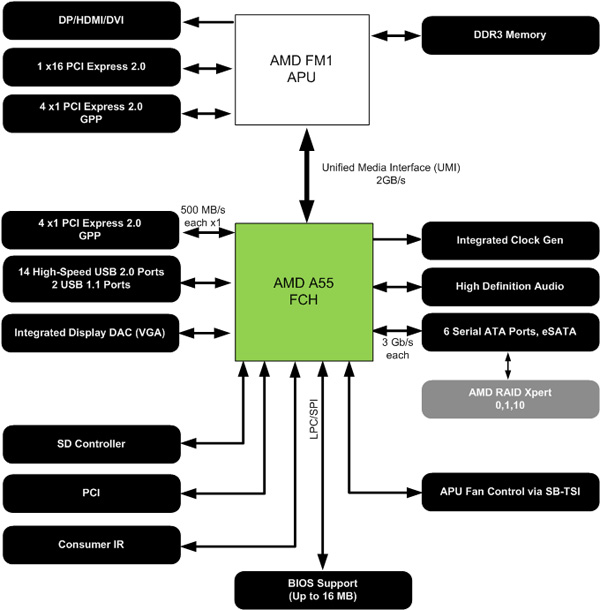


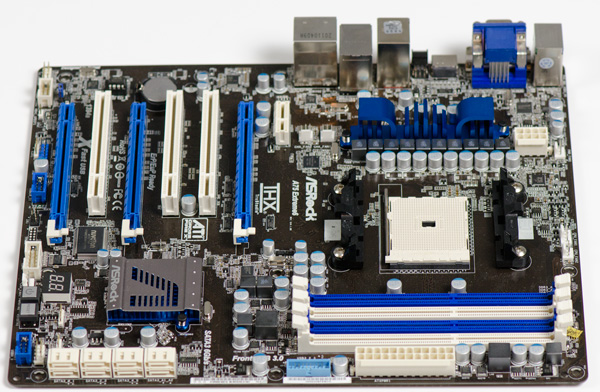
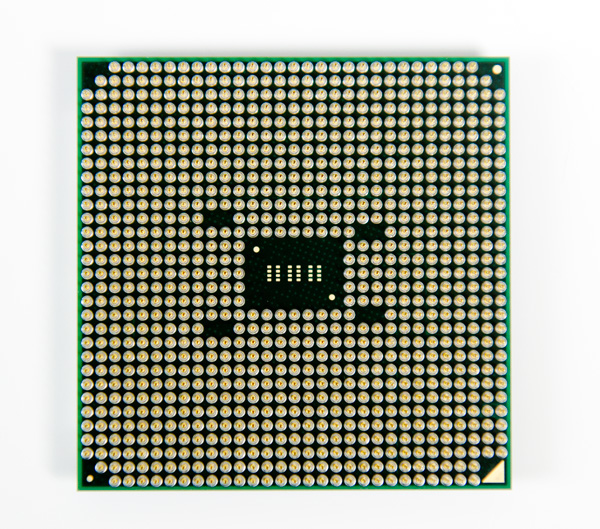
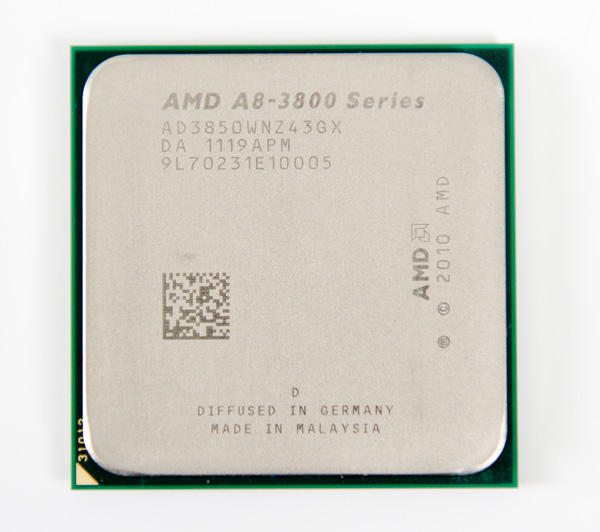
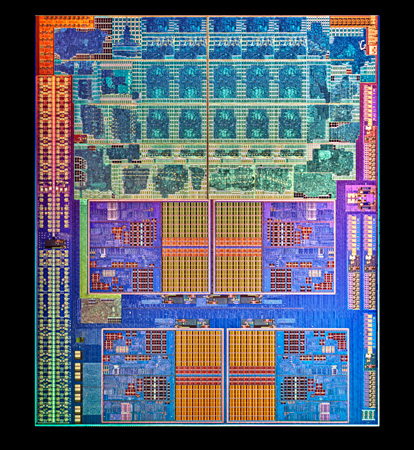








99 Comments
View All Comments
silverblue - Thursday, June 30, 2011 - link
So, in other words, you completely skipped over what I posted, especially the comparisons between similarly clocked parts? In that case, you may not recall my saying that comparing to Thuban was unfairly skewed in AMD's favour and that for productivity you'd have to be mad to fork out for a high-end Core 2 Quad that is soundly beaten by Thuban under those very circumstances.I'm not going to spend anymore time on this subject for fear it may cause my brain to dissolve.
silverblue - Thursday, June 30, 2011 - link
We really don't know how Bulldozer will perform. Superior in some areas, inferior in others, perhaps. Its roots are in the server domain so it probably won't be the be-all-and-end-all of desktop performance. Should handily thrash Phenom II though.That is, if they stop pushing it backwards... if they do it anymore we may as well wait for Enhanced Bulldozer. :/ I can only truly see Bulldozer being a 9-12 month stop gap before that appears, and as we know, Trinity is going to use the Enhanced cores instead of first generation Bulldozer cores, so it remains to be seen how long a shelf life the product will have.
duploxxx - Thursday, June 30, 2011 - link
Ivy Bridge before buldozer, oh man you really have no idea about roadmaps...Server and desktop will be there long time before Ivy, if they don't hurry with Ivy even Trinity will be ready to be launched.
j_iggga - Thursday, June 30, 2011 - link
Single and double threaded performance is most important for games.Bulldozer has no chance in that regard. The only hope Bulldozer has is that it outperforms a quad core Intel CPU with its 8 cores in a fully multithreaded application.
L. - Thursday, June 30, 2011 - link
GPU's are most important for games, that and a CPU that can feed your GPU's ;)More and more stuff is using 4+ threads, I'd be surprised if the next benchmark from Crytek isn't vastly multithreaded on the CPU side.
We'll see anyway, but the design choices AMD made for Bulldozer are definitely good, as were their multicore designs that Intel quickly copied - for the best.
frozentundra123456 - Thursday, June 30, 2011 - link
Are you kidding me??? If Bulldozer is so great why do they keep having delay after delay and are showing no performance figures??HangFire - Tuesday, July 5, 2011 - link
Given the number of Nocona CPU's Intel sold- as evidenced by the huge number showing up on the secondary market right now- Intel server shipments won't die even if they have an inferior product (again).The faithful will buy on.
L., you seem to be betting on a jump for Bulldozer that will exceed that of C2D over Netburst. I'm not sure that's even possible. C2D only lacked a built-in memory controller, and that has been fixed. I'll be happy if BD even matches Nehalem in core instruction processing efficiency.
But I agree the more progress AMD makes, the better the market is for all of us, no matter which we buy.
frozentundra123456 - Thursday, June 30, 2011 - link
totally agree with your post. Just a weak gpu tacked on to ancient CPU architecture that could easily be beaten by a 50.00 discrete GPU in the desktop.I can see a place for this chip in a laptop where power savings is important and it is not possible to add a GPU, but for the desktop, I really dont see a place for it.
And I agree that Bulldozer is late to the game and may not perform like the AMD fanboys claim. AMD talks a good game, but so far they have not been able to back it up in the CPU area.
jgarcows - Thursday, June 30, 2011 - link
Can you use OpenCL with the Llano GPU? If so, how does it perform for bitcoin mining?JarredWalton - Thursday, June 30, 2011 - link
Yes, Llano fully supports OpenCL -- it's basically a 5570 with slightly lower core clocks and less memory bandwidth (because it's shared). On a laptop, Llano is roughly half the performance of a desktop 5570 (around 40Mhash/s). The desktop chip should be about 40%-50% faster, depending on how much the memory bandwidth comes into play. But 60Mhash/s is nothing compared to a good GPU. Power would be around 60-70W for the entire system for something like 1Mhash/W. Stick a 5870 GPU into a computer and you're looking at around 400Mhash/s and a power draw of roughly 250W -- or 1.6Mhash/W.In short: for bitcoin mining you're far better off with a good dGPU. But hey, Llano's IGP is probably twice as fast as CPU mining with a quad-core Sandy Bridge.